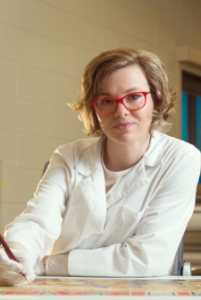 Considered by most as “back of the house,” conservation is critical to all museum functions. We sat down with Chief Conservator Joanna Didik to shed light on the important work her team does daily to make Gilcrease a world-class museum.
Considered by most as “back of the house,” conservation is critical to all museum functions. We sat down with Chief Conservator Joanna Didik to shed light on the important work her team does daily to make Gilcrease a world-class museum.
Q: Where are you from?
A: I am from Torun, Poland.
Q: What was your career path before landing at Gilcrease?
A: Right after university, I took a position in State Archives of Poland and three years later in National Archives of Ireland, where I worked until 2015. One may think that archives are very different from a museum, but if you think about them as memory institutions (that’s what they are called in Europe) there are a lot of similarities. Regardless of the type, every collection not only corroborates the fact of the existence of the past and is an agent of its valuation and dissemination, but also contributes to understanding the present.
Q: When it comes to conservation and science, there is a lot of overlap. What type of science background do you have?
A: Indeed, there’s a lot of science in conservation. During my six years at the university, we had courses covering general and organic chemistry, physical chemistry, polymers and labs. In other words, I was exposed to all the possibilities one can encounter in conservation.
Q: How big is the conservation team at Gilcrease, and what are the different roles?
A: Our team is three-women strong: two conservators (paper and objects) and one technician. Our work is mainly driven by exhibitions, and we need to keep up with the preparation of the objects requested.
Q: Why is conservation critical to a museum?
A: Conservation in a museum is the intersection of all institutional functions. Imagine a collection in such bad condition that it’s rendered unusable. All the museum responsibilities would be impaired or impossible to carry out. Because of the strong scientific foundation of the discipline, we are acutely aware of the importance of preventive conservation measures. This is also why conservation is a common effort of the whole museum team.
Q: What is the biggest “enemy” of artwork in museums?
A: In a gallery space, it would be human touch or scratches from people’s bags.
Q: What do you enjoy most about your day-to-day job?
A: The learning. Every day there’s something new to embrace — the unexpected configuration of materials in an object, a damage that doesn’t make sense at first glance, an unknown bug, or finding a housing solution for a difficult object. There is a lot of excitement in figuring all that out. It’s kind of like Sherlock Holmes.
Behind the Scenes with Joanna Didik – Wet on Wet Paper Conservation